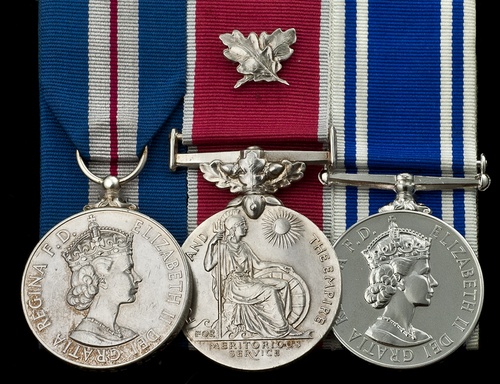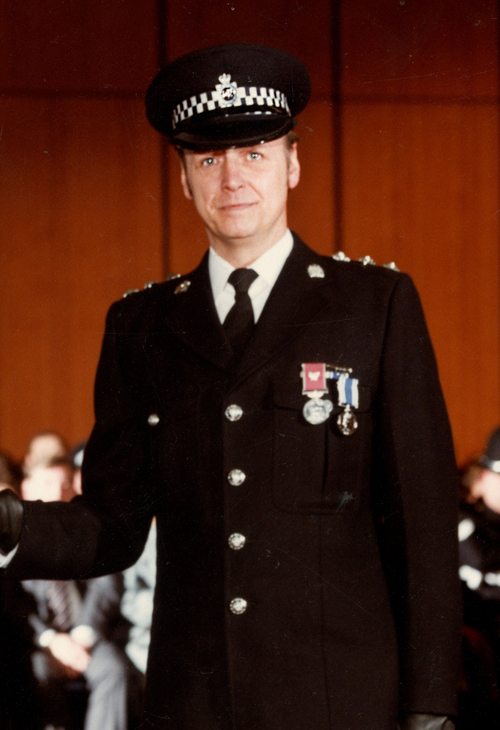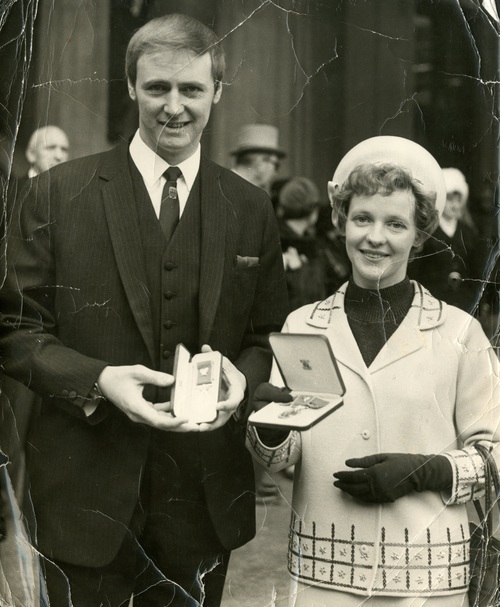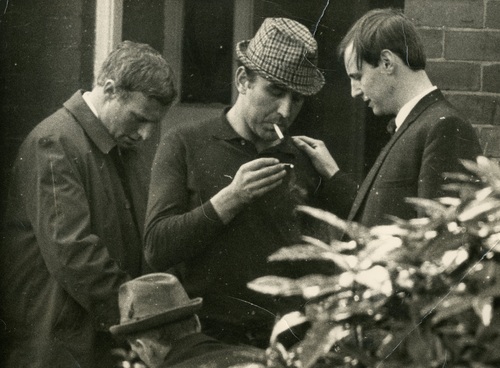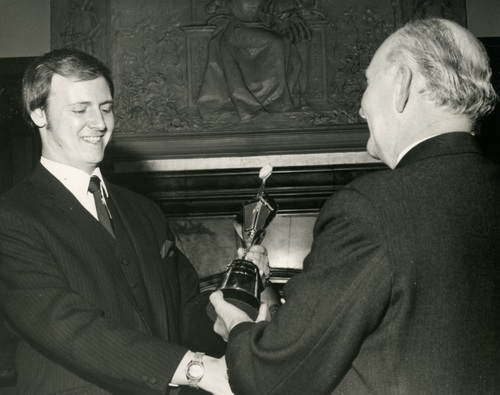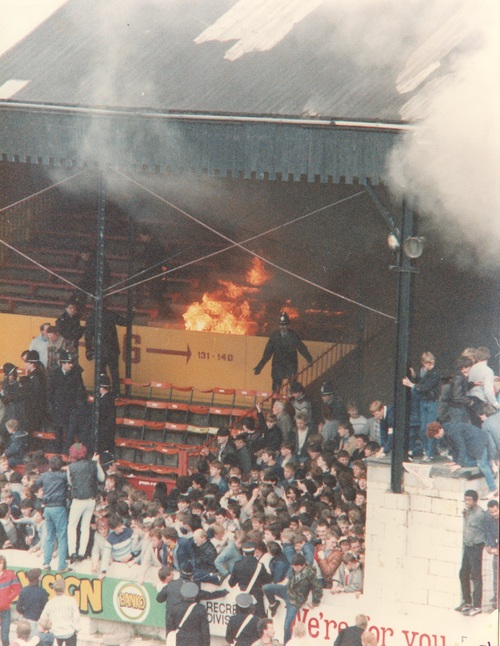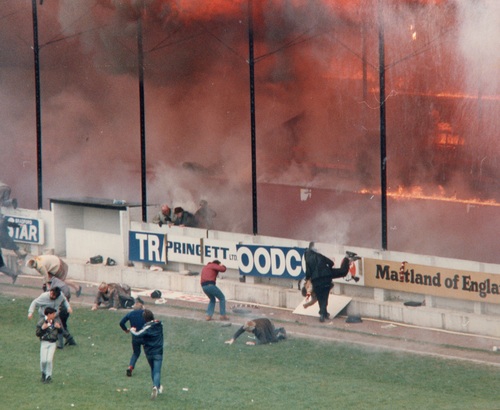Auction: 16003 - Orders, Decorations, Campaign Medals and Militaria
Lot: 22
SOLD BY ORDER OF THE RECIPIENT
The Important and Exceptionally Poignant 1985 'Bradford City Fire Disaster' Q.G.M. and 1970 Castleford 'Armed Siege' B.E.M. For Gallantry Group of Three to Chief Inspector T.M. Slocombe, West Yorkshire Metropolitan Police, Who Was Instrumental In The Raising Of An Armed Siege in 1970, Later Acting In The Police Response To The Disaster at Valley Parade Football Ground, 11.5.1985, Saving An Elderly Man From The Blaze, And Who Entered The Blazing Inferno To Rescue Trapped Supporters, The Worst Fire Disaster In The History Of Football
a) Queen's Gallantry Medal (Terrence Michael Slocombe, B.E.M.), with the Royal Mint case of issue
b) British Empire Medal, E.II.R, Civil Division, with Oak Leaves for Gallantry (Terence Michael Slocombe), edge prepared prior to naming, with the Royal Mint case of issue
c) Police Long Service & G.C., E.II.R. (Inspr Terence M Slocombe), with the Royal Mint case of issue, light contact marks, good very fine, mounted court-style as worn, together with the following archive of material:
- The letters of confirmation for both awards
- Five photographs of the recipient
- The recipient's West Riding Constabulary Note Book, covering the dates 7.4.1970-20.5.1970
- Letters of congratulations relating to both awards
- Original photographs relating to investigation following the 1970 Castleford Siege
- Police report following 1970 Castleford Siege
- Original Police radio transcripts of events relating to Bradford City Fire
- Photograph album containing images of the investigation following Bradford City Fire
- DVD (converted from original VHS) containing 45 minutes of footage of the Bradford City Fire and subsequent investigation
- Bradford City Vs Bradford City Programme, 11.5.1985
- A quantity of copied letters relating to the Bradford City Fire Disaster
- An archive of newspaper cuttings related to the recipient's career (Lot)
Q.G.M. London Gazette 29.5.1986 Chief Inspector (formerly Inspector) Terence Michael Slocombe, B.E.M., West Yorkshire Metropolitan Police
'On 11th May 1985 at approximately 3.40 p.m. fire broke out in the main grandstand at the Valley Parade football ground in Bradford. Police officers and spectators assisted in the initial evacuation but the fire spread rapidly to the roof. Within seconds the entire structure was ablaze. Intense heat and breathing difficulties forced rescuers to retreat to the comparative safety of the playing area.
Inspector Slocombe's initial involvement in the
evacuation continued until the heat caused his tunic to catch fire and it had to be removed. Shortly afterwards, he saw that spectators were still in great difficulty. Inspector Slocombe ran forward taking a police officer's coat to use as a shield against the ferocity of the fire. He managed to grab an elderly man who had collapsed near to a perimeter wall. With assistance from a spectator he was able to pull the man away from the fire.
Chief Inspector Mawson and Inspector Slocombe were aware that a number of people were trapped in a toilet adjacent to the blazing stand. The officers ran towards the inferno and entered the toilet. With assistance from another police officer they took hold of three people. The group then ran from the toilet to the pitch, and had to avoid large quantities of falling debris on the way.
These four police officers and two civilians displayed outstanding courage and bravery. Despite severe fire and extremely dangerous conditions they acted in a way which endangered their personal safety in order to save lives.'
B.E.M. for Gallantry London Gazette 29.11.1970 Constable Terence Michael Slocombe, West Yorkshire Constabulary
'A call was received by the Police to the effect that a man was in a house in possession of a gun and that he had two children with him. Police officers went to the scene and found that a mentally disturbed man had lodged himself in an upstairs room with two of his children. He was in possession of a loaded shotgun and ammunition and indicated that unless the officers vacated the house he would harm the children or himself. The officers accordingly withdrew. During the next two hours a number of shots
were fired by the man during the course of which damage was caused to a car and a Constable was injured. The man carrying the shotgun then left the house accompanied by his children, making use of them as a form of shield. He then approached a house occupied by Mrs. Simpson and her two children. Mrs. Simpson knew the man personally and was well aware of his mental state. She had also been previously warned by the Police of his activities and advised to lock herself in the house. On reaching the house the man pointed the gun at her through the glasswork of the door and demanded admittance. Mrs. Simpson could readily have taken cover and avoided personal injury from any shot fired but fearful of the possible consequences to the children if she did not comply, she opened the door. On entering the house the man locked the door and ordered Mrs. Simpson upstairs where together with the four children they occupied the front bedroom, the -man taking up a position by the window armed with the gun. For the following 19 hours Mrs. Simpson and the children were held hostage in the house by the man who was in a highly emotional and dangerous state throughout. There is no doubt that at various times during her ordeal. Mrs. Simpson could have escaped from the house either alone or with one or more of the children but she refused to accept such opportunities until she was able to collect all the children together and emerge to safety. It was continually apparent to her that the man was under severe mental strain and that in such a condition his reactions to anything untoward which she might do could well have had tragic consequences. In spite of this frightening situation she did all in her power to pacify the man, whilst at the same time watching for an opportunity to make a joint escape. Eventually, Mrs. Simpson was able to persuade the man to talk to Constable Slocombe who was keeping observation in the house opposite. This he agreed to do and Constable Slocombe crossed to the front of the house. He was unarmed and unprotected and was fully aware of the dangers involved. Nevertheless he endeavoured to persuade the man to surrender and release the hostages, but without success. Following this initial meeting Constable Slocombe later talked to the man on at least six occasions. At all times he was standing in a very vulnerable position in the front garden with the shotgun pointed in his direction. The following morning a shot was fired from the rear of the besieged house and a few moments later Mrs. Simpson and all the children were able to run from the front door leaving the gunman alone in the house. Immediately, Slocombe took up a position at the front door facing the besieged house although he could appreciate the man's mental state on realising that his hostages had escaped. The man appeared at
the window with the shotgun and Slocombe called to him to give himself up and drop the gun out of the window but he refused to do so. Slocombe continued to talk to the gunman in a quiet, convincing manner and again assured him that if he would drop the gun outside he would go into the house alone and talk to him. Eventually the Officer succeeded in convincing the gunman who dropped the gun outside whereupon Slocombe went forward and met him as he emerged from the house.'
Chief Inspector Terence Michael Slocombe, Q.G.M., B.E.M., born Odsal, Bradford, 23.11.1943, the eldest son of Arthur Gwynne Slocombe. Educated at Low Moor Church School and Grange Grammar, Bradford, leaving aged fifteen due to family circumstances lacking any qualifications. Slocombe initially took employment as an Office Boy at Seymour Shirt Makers, Bradford, where he worked for two years. Aged seventeen, he then served as a Police Cadet in the West Riding Constabulary, undertaking training at The Police Training School, Pannal Ash, Harrogate. He was appointed Police Constable, 23.11.1962, with patrols in Keighley and Castleford before the amalgamation of the force during 1974. Promoted Uniform Sergeant, 29.7.1974, Uniform Inspector, 24.10.1977, Chief Inspector, 4.11.1985, his final appointment being as Superintendent Divisional Officer at Eccleshill, Bradford from 1.1.1993, retiring on 29.3.1995. Throughout his career Slocombe received numerous commendations, including from the Royal Humane Society in the resuscitation of a woman after a fall. He married Christine in 1965, with issue of two children. Since his retirement, Slocombe has raised funds for the Burns Unit Appeal at Bradford Hospital which was established following the Bradford City Fire Disaster by driving his 1936 Morris from Valley Parade to Lincoln and back.
Armed Siege at 46 Sheepwalk Lane, Castleford
During the 13th April 1970, a long armed siege developed at 46 Sheepwalk Lane, Townville, Castleford, West Yorkshire. It was finally lifted the following morning, following the bravery and gallantry of (at that time) Detective Officer Slocombe. In collaboration with other members of the West Riding Constabulary and the cool headed actions of Mrs Maureen Simpson the long stand-off with William Norton Atkinson was raised. Atkinson, a 31 year old local man, initially visited his parent's house at 50 Sheepwalk Lane in the afternoon, taking his daughters hostage and acting aggressively. As a result the police were called and visited the household, driving Atkinson upstairs with his hostages, being overheard saying '...You can go away, if you don't I'll see to these kids.' Unsurprisingly, the Officers attending vacated the property in the hope that the situation would defuse. With a police cordon now in place, he then began firing, with four to six shots heard, damage being caused to cars and local houses, with Police Constable Sellers receiving injuries to the eyes as a result. The gunman thence left the property and relocated to 46 Sheepwalk Lane, the home of Mrs Simpson, at which point he took her and her two children hostage too. The report gives more information of the subsequent events '...4.50pm Atkinson permitted Mrs. Simpson to leave the house and make contact with P.C. Slocombe.
5pm P.C. Slocombe crossed to the front of the house now occupied by Atkinson, Mrs. Simpson and four children. He tried to persuade Atkinson to surrender, to release the hostages and asked what conditions or action Atkinson was demanding. P.C. Slocombe persuaded Atkinson to talk to The Chief Constable. In total P.C. Slocombe crossed or stood in a vulnerable position in Sheepwalk Lane, at times in front garden of 46 Sheepwalk Lane, to talk or encourage Atkinson to cease the current situation on at least six occasions.'
His efforts that evening however were futile, with no successful cessation of the siege, the children at danger throughout. With the dawn of 14th April 1970, the siege was finally ended. Following a fruitless discussion with Atkinson, which was followed by shots being fired towards the Police cordon, his hostages escaped, with Atkinson eventually surrendering himself to Slocombe. The Minute Sheet of Chief Inspector Guscott sheds more light to the end of the siege and Slocombe's involvement:
'...To agree to make contact with Atkinson and from the first approach to the house, to a position within gun shot range, D.O. Slocombe displayed a calmness and courage in excess of what one could expect of a Police Officer. The patience and even tenor of his conversations with Atkinson, the outward confidence shown by this Officer to a man holding hostages and in possession of a double barrelled shot gun, which had already been discharged on several occasions, causing shot gun injury to one officer, was commendable to the extreme. To repeat the manoeuvre of placing himself in a position of danger on at least six occasion to maintain contact and gain the confidence of Atkinson is courage of high standing. The confidence inspired by D.O. Slocombe in Atkinson led to Atkinson surrendering the shot gun, and himself, without further injury to persons or property. I consider the action of D.O. Slocombe at this incident worthy of the strongest recommendation.'
The incident was widely reported in local and national newspapers, and led to Slocombe receiving the West Yorkshire Police Authorities Award for Courage and Meritorious Devotion to Duty. Mrs Simpson was also awarded the B.E.M. for her actions.
Bradford City Fire Disaster
Saturday 11th May 1985 began as a day of celebration for Bradford City Football Club. Their match against Lincoln City was also the day on which they received the Football League Third Division trophy, being the clubs first silverware for fifty six years. As a result, 11,076 supporters were in the ground, including around 3,000 in the main stand. The match began as usual, with the first half being played in a stale nature. At around the forty minute mark, however the first signs of a disaster were seen, with smoke emanating from the rear of Block G. Upon the Police radio register, at 3.43pm 'Report of a fire at the main stand request for doors to be opened' is noted. By 3.45pm the referee had stopped the match and in just four minutes, at 3.49pm the report states 'The Main Door are on fire we cannot get anyone out'. Panic soon spread as the crown attempted to evacuate the stand. Within a few minutes the small blaze had engulfed the entire stand, creating a black smoke which blocked an escape passage to the rear of the stand. Footage shows the grave intensity and ferocity of the blaze, with Police Officers and supporters acting in the rescue of other attendees. A copy of Slocombe's statement, dated 17.5.1985 gives his report of the entire event:
'I am Police Inspector of the West Yorkshire Metropolitan Police stationed at Bradford Central. On Saturday 110585 I was on duty as the Sub Divisional Patrol Inspector commencing at 0700 hours with responsibility for the city centre policing and public order control prior to the football match to be played between Bradford City and Lincoln.
At about 1230 hours that date information was received that certain Bradford City fans known collectively as 'The Ointment' were being sighted in the city. In view of the potential disorder their presence might encourage I undertook a watching brief on the various location they might visit.
Various individuals started to meet up and eventually a group numbering between eighty to a hundred were observed visiting public houses in the city centre. The group were seen to walk down Westgate toward Ivegate and I noticed that they had obtained aerosol canisters of spray paint or something similar.
The colours appeared to be predominantly green, yellow, orange and red. The members of this group had sprayed their hair with one or more of the colours. Although the group was seen to spray other people it was a reasonable assumption that anyone neatly wearing the colours were associated with this group.
After visiting various public houses the group made their way to the football ground at Valley Parade. No disturbances were relating to the group who were in high spirits. In view of the antecedents of 'The Ointment' I made arrangements for a Police photographer P.C. Hall Headquarters to attend the match with a view of identifying any person engaged in public disorder.
I resumed duty on the public order aspect. There was no trouble in the city centre prior to the match which could be attributed to football supporters and there was a good feeling in the city. This was no doubt due to the success enjoyed by the football team who had been confirmed as the Third Division Champions. It had been arranged that the football team would receive the award prior to the commencement of that afternoons match.
P.C. Hall arrived in the city from Wakefield and I met him in South Parade outside the club entrance. I briefed the officer and entered the football ground with him. On entering the playing area I saw that the football team was receiving their awards near to the players entrance in front of the stand.
There was a carnival atmosphere and everybody appeared to be enjoying themselves. I saw no signs of trouble.
My position at this time is indicated on a map of the ground. This position is marked '1'.
Several people in the stand near to the presentation area had green colouring to their hair but I could not identify any individuals. Whilst with the photographer I did not note any incidents or disorder occurring. The match was well supported and I would estimate that some ten to twelve thousand people were present. The main stand on the South Parade side of the ground contained some three thousand persons. The Bradford Shed on the Hollywell Ash Lane side of the ground is a standing area and this was relatively full without being uncomfortable. I recognised one person in the crowd as an off duty officer P.C. Boyes of Odsal Division. The Midland Road stand again a standing area was comfortably occupied and I noticed that television cameras were operating from the centre of this stand.
The Spion Kop was well filled the majority of those persons being on the South Parade side. My visit to the ground on this occasion was brief and I resumed public order patrol duty. I was with P.C. 3090 Wetherall and P.C. 4579 Bannon as a mobile patrol in the Divisional van.
I returned to the ground at sometime about 1520 that date. On entering the prisoner reception room via the sliding door from Hollywell Ash Lane I saw from the log that some six or so persons had been arrested.
Shortly afterwards I received a radio communication. From records on the command and control computer I can say that a 999 call was received at Force Control Bradford to the effect that two asians had been assaulted and as a result two white men had been chased into a warehouse situated behind the executive car park with an entrance from the top of Hollywell Ash Lane. I have marked the map with '2' to indicate this location.
Records show that P.C. Weatherall [sic], P.C. 1455 Boyce whom I had picked up a short time earlier and P.C. Bannon I attended at that location at 1529 hrs. We searched the premises and subsequently made two arrests. The arrests are recorded as being at 1534hrs.
The prisoners were conveyed to the Central Charge Office in the city centre by my officers and I walked back to the prisoner reception unit a distance of some thirty yards. I have marked the map at '3' indicating the location of the reception unit. On entering the ground office a prisoner Peter Kevin Newby was just being processed. Newby said words to the effect of 'How can you be arrested for threatening behaviour when there's no one from Lincoln?'
About this time I looked out of the reception unit window which overlooks the South Parade side of the Bradford Shed and a part of the path used as a players entrance. The game seemed in progress and I saw some majorettes dressed I believe in blue clothing moving back up the slope from the ground. Their location is marked on the map at '4'.
Knowing that the majorettes would be performing on the pitch at half time I anticipated that the game would cease at any time and I started walking out of the reception unit towards the players entrance to enter the playing area. Whilst still in the building but close to the outer door I heard works to the effect of a pitch invasion. These words came from outside the building.
Due to obvious implications I immediately left the building and went to the playing area a matter of some fifteen paces. When I reached the edge of the pitch perimeter I marked on the map I had a clear unobstructed view along the main stand towards the Kop. Two persons that I cannot identify were climbing over the wall in front of what I now know is G Block. The point the persons were reaching is indicated on the map at '5'.
In view of the situation fearing some time of disorder I quickened my pace with the intention of going to that area. I know that this location usually contains members of The Ointment. I had reached a point some five yards along the touchline marked '6' on the map halfway along the clubhouse when I saw a small amount of smoke rising from the area of G Block. As I walked a little further I saw what appeared to be small insignificant flames near area of the smoke. In view of this I quietly asked people to move towards the Bradford Shed end as 'Something appears to be happening.' Some people did move slowly and other the majority continued to watch the match. Police Officers were in the vicinity of the area and dealing with the situation. This was confirmed in a radio communication.
At this time I had no indication of the problem about to arise and my speech was demanding but advisory.
On reaching a point close to the trainers bench marked '7' on the map I realised that there was a more urgent need for action as the smoke was denser. The crowd at that location were moving more quickly yet not in a panic situation from the area of G Block.
There was no sign of panic at my location although it was obvious that more persons were climbing over the wall onto the pitch in front of G Block.
There still did not appear to be a panic in that area. Police Officers were stood in G Block ushering people away from the fire in the direction of the pitch. Several people were still chanting Bradford City when they stood on the pitch and seemed to be treating the matter fairly lightly. The match as far as I am aware was still progressing. People in the stand at my location were obviously still watching the field of play.
I advised those at the front of the crowd to climb over the stand wall and those to the side and back to move towards the Bradford Shed away from the area of smoke. There was more demand to my voice but fearing a panic situation causing crushing my main concern was to remove people from the front of the stand.
The smoke then rapidly accelerated in thickness and more people throughout the stand were aware of the fire. This in turn accelerated the need of evacuation and a panic situation was not far away. This was brought home to me by the fact that persons from G Block were pushing their way along the back of the stand and in a diagonal line from the fire towards my position.
Although advising people to remain calm assisting them over the wall as rapidly as possible and passing children to those already on the field of play I realised then that the situation was grave.
I believe other Officers were in the immediate vicinity but I cannot recall identifying any of them. It was necessary to concentrate only on that area and matters on the periphery would not even be noticed. Constant radio messaged were fed to and by the Police Control Room involved. The pressure of people coming into my area from the rear of the stand and the direction of G Block fuelled the panic situation so much that occupants at the front were being trapped against the wall. It was neccessary to literally haul people out and throw them onto the pitch without cares of how they were landing. This included elderly persons.
The heat had increased incredibly quickly and we had to continually haul people out. An elderly couple stated they could not climb over the wall and another person assisted me to pull them over the wall.
At this stage we had a true panic situation because of the pressure of the crowd.
I pulled an elderly man over the wall the only identity I can give is that he had a walking stick which was dropped over the wall onto the pitch side. A elderly woman was pleading to be assisted and it was impossible to help everyone. I could not manage to pull her out and she was being crushed against the wall. A Police Officer then helped me pull the woman out with such force that she was thrown onto the pitch. I never saw her again.
By this time I believe the roof of the stand was on fire and dense smoke was building up in our area. The heat was bearable but breathing was becoming laboured.
Suddenly people at the back of my ground appeared to be steaming and were in urgent need of rescue but it was impossible to work any faster. Somehow I cannot recall moving I found myself on the B Block side of the trainers bench. This position as estimated is marked '8' on the map. I was holding onto a woman who appeared to be on fire or scorching. It was only possible to pull her part way up the possible a quarter of the way over when she slipped and fell backwards.
At this time the heat was intense and I could not breathe. I felt I could not stay and ran towards the centre of the pitch. Although I believe I could hear screams I could not do anything about it. This obviously caused my distress.
Some days later I was informed that P.C. 3986 Sullivan of Central Division who was off duty at the match left his children in the centre of the playing field and dragged this woman safely over the wall and on to the field.
Because of the heat and the fact that someone shouted 'You're burning', I threw my jacket off, at that time I saw a man falling over the stand wall somewhere to the left of the trainers bench. The proximity of the location is indicated on the map at '7'.
The man appeared to be elderly his clothing was smoking and he appeared to be badly injured. He appeared to be stuck on the wall. I saw a Police Officer unidentified run towards the man and I also ran in that direction. The Officer pulled him onto the pitch.
I had to hesitate because of the heat and it was impossible to venture further without outer clothing. This would be some twenty yards away from the man and I grabbed a gannex raincoat of a Constable who was nearby. With the coat over my heat I was able to approach the man but the heat was intense. The Officer who had reached the man had managed to get him to the edge of the pitch but was unable to drag him to safety unassisted. The man was face down and I believe he was wearing spectacles. Some six feet from the man I also ran back because of the heat but with the help of the raincoat over my head we managed to start dragging the man towards the centre of the field. I believe we were joined by a civilian who helped us drag the man to safety.
The heat near the stand at this time was unbearable and there appeared to be a lack of oxygen. This prevented any thoughts of further rescue. I cannot say whether or not any people were in the stand or in a position to be rescued [A hand annotated note adds 'Only 3 bodies at front of stand. RESCUEABLE?']
The injured now became a priority and I started to check on the casualties. It was at this time that the full implications were realised and I gave instructions to operate the casualty bureau which is used in major disasters.
Some fans were still chanting mainly 'Bradford City' cheering and running about. I do not know if they had realised what the situation was. People with various injuries were sat or laid on the pitch. Many people were dazed and did not comprehend what was actually happening. Many people were approaching Police Officers stating that they could not find their friends and relatives some wanted to go to the stand to search and had to be restrained.
Although there was a certain amount of confusion Police and civilians alike were trying to assist. It was necessary to attempt to establish some semblance of order and involve everyone in something to lessen the panic and distress.
Numerous people who had become detached from their relatives or friends were unintentionally hampering Officers from giving First Aid by persistently asking for assistance to find them. They were told to report to Officers outside the ground and give details of persons who had been with them.
To assist in the evacuation of the crowd civilians were asked to volunteer to carry injured people from the ground. In groups of six to eight civilians were show how to place coats under the injured and convey them to the Midland Road exit marked '9' on the map.
Some of the burns were terrible in that skin was hanging from bodies clothing burnt away and some clothing was still smouldering. A great many people had facial blistering, hand injuries and those who had been (wearing) nylon type clothing had melted nylon on their bodies.
Although I seemed to have been actively engaged for a long time in hindsight it could not have been longer than a few minutes.
The removal of the injured was the upmost priority at that time and I moved towards the Bradford Shed checking on injured persons and obtaining volunteers to deal with them.
En route and I can only hazard a guess at my location as marked '10' on the map I saw a man walk from the stand near to the players entrance marked '1' on the map. The man was a mass of flames yet had no urgency about his pace. He seemed to quietly walk onto the pitch and was immediately approached by a Police Officers and civilians who beat him with clothes to extinguish the flames. The man fell to the ground and many people tried to smother the flames with coats. I only recognised one person Chief Inspector Mawson who had to dissuade so many people from helping as they seemed to be getting in each other's way.
There was no assistance I could offer and I was then approached by a man who identified himself as a Nursing Officer. He was in civilian clothes and offered assistance in identifying priority injured persons for removal. He was immediately engaged in this task.
By this time I was somewhere in front of the Bradford Shed probably ten yards from the pitch footway marked at '11' on the map. I looked towards the stand and the players entrance marked 'I' on the map. I saw three or four people stood in the entrance to the ladies toilets. One person I cannot state either sex or age appeared to be on fire and a figure was throwing something at that person.
By this time the whole of the stand was alight and there was a danger of the group of people being trapped. From past experience I knew that they would be in difficulties due to the heat and breathing problems. I ran towards the group and shouted to a Police Officer later identified as Chief Inspector Mawson to follow me.
We ran to the toilet building. Mr Mawson took the arm of the burning person and the second member of the group took the other arm. Immediately prior to running out a man whom I believe to be a member of the ground staff threw water over the group. The group then ran from the stand avoiding falling debris. I did not see the civilians again as far as I am aware.
I grabbed the third man and with the benefit of water thrown over us by the groundsman we all ran from the stand. I think other people approached us on the pitch and I did not see the civilians again.
By now the evacuation of the injured was working relatively well although a large number of injured persons were still on the ground.
I was approached by a man Michael Capper who lives at the Cup and Rung Coach Road, Baildon and he stated that he believed his two sons were still in the stand. He was advised as to what action to take and was instructed to leave the ground. There were fears that some relatives may still wish to take the impossible task of entering the stand to search for their relatives.
We continued to tend to the injured. One man laid on his back and beside burn injuries looked very pale and may have been having some heart failure. Immediate steps were made for his removal. Another person laid face down. His clothing had been burned from his back and he had severe back injuries. He was also treated with priority.
The casualty clearance continued and Police Officers with recruited civilians started to persuade everyone to leave the ground via the Midland Road exit mark '9' on the map.
Order began to take over and the situation appeared to be under control. Reinforcements had been called in and various plans had been implemented for recording those attending the match, casualties, missing persons, property checks and the other requirements that were necessary.
Suddenly it appeared to be all over in relation to the immediate action and people were beginning to allow themselves to think of the consequences. It just seemed to be a fairly calm moment and it was amazing to acknowledge that what seemed an eternity was in actual fact a relatively short time. Statement taken by self.'
Following the disaster, Slocombe remained at the ground to assist in the evacuation and treatment of the casualties. The Police radio at 5.49pm noted 'Insp Slocombe is in charge inside the ground.'
A total of 56 people lost their lives, with at least another 265 being injured. This made the Bradford City Fire Disaster the most costly fire disaster in the history of football. A memorial service was held at the ground, 21.7.1985, in the shadow of the stand to commemorate those who lost their lives. In remembrance, by the City Hall memorials a minutes silence is held each year at 11am, 11th May, with Bradford City F.C. adopting black trims to the shirt collars and arms as a permanent memorial to those who lost their lives.
Six Q.G.M.'s were awarded for the Bradford City Fire Disaster, four to members of the West Yorkshire Metropolitan Police and two to civilians for their actions.
Approximately five Q.G.M.'s to the West Yorkshire Metropolitan Police.
The combination of Q.G.M and B.E.M. for Gallantry is approximately one of two at date of publishing.
Subject to 20% VAT on Buyer’s Premium. For more information please view Terms and Conditions for Buyers.
Sold for
£10,000

